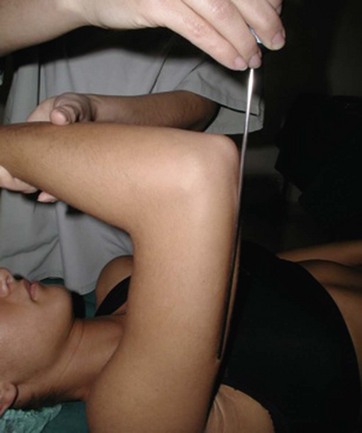Chapter 2 Liposuction of the upper extremities
• Patient selection is crucial and the skin quality of the target region should be assessed.
• Deformities should be classified, and simultaneous or late excisional surgery should be discussed with the patient.
• Conventional technique can be used or energy delivering technology can be used to get better skin retraction.
• Gentle surgical technique should be used and soft tissue thickness should be even and esthetic contours should be achieved at the end of the procedure.
• To get a smooth result the surgery should be extended to the entire esthetic unit of the arm.
Preoperative Preparation
Patient Selection
The classification of Teimourian1 has been generally accepted for esthetic deformities of the arm (Table 2.1). Besides Teimourian, other classifications reported by El Kathib2 and Appelt3 can also be used. While liposuction can be used alone in class 2 deformities, it can be used alone or can be combined with a brachioplasty technique in class 3 deformities.
TABLE 2.1 Teimourian Classification
| Group 1 | Minimal to moderate subcutaneous fat with minimal skin laxity |
| Group 2 | Generalized accumulation of subcutaneous fat with moderate skin laxity |
| Group 3 | Generalized obesity and extensive skin laxity |
| Group 4 | Minimal subcutaneous fat and extensive skin laxity |
Chamosa’s cadaver study4 on fat deposits supports our clinical findings. Fat deposits in the arms are mostly located at the posterior area. Superficial fascia separates the fat layer into superficial and deep compartments and the storage of fat occurs in each compartment. Skin retraction is better in superficial liposuction technique. When combined with the use of internal ultrasonic and laser systems, better skin retraction is obtained due to increased dermal thermal energy.
Surgical Technique
SAL
There are two basic operating positions during infiltration and liposuction. The arm should be held perpendicular and the forearm should be flexed into the first position (Fig. 2.1). In this way, the posterior arm can be kept stretched to ease the operation. In the second position, the surgical assistant should lift the arm to a 90° degree angle by holding the wrist. In this way, contours of the posterior arm become visible due to gravity. Using the pinch test, the thickness of adjacent esthetic units, which is the target thickness, can be gauged. The procedure should carry on until the desired thickness is achieved. After the desired thickness and esthetic contour has been achieved, four tests should be applied, which are similar to those applied to other body parts. After rubbing, pinch, active pinch and comparison tests, additional adjustments should be done to complete the procedure if needed. Stab incisions may be closed as two layers with separate 5/0 Monocryl sutures or kept open for drainage. A liposuction arm corset should be applied to the arm.
< div class='tao-gold-member'>
Stay updated, free articles. Join our Telegram channel

Full access? Get Clinical Tree


 enyuva,
enyuva, 




